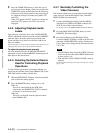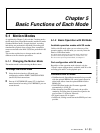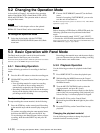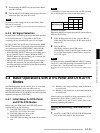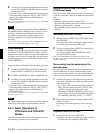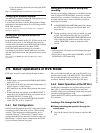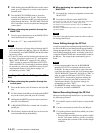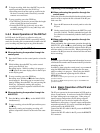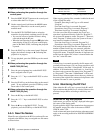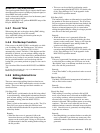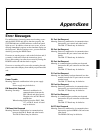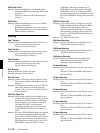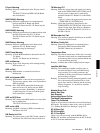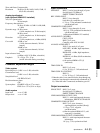
Chapter 5 Basic Functions of Each Mode
5-8 (E) 5-5 Basic Operations in BVE Mode
Playback through the P2 and P3 Ports
x When performing the operation through the
control panel
1
Press the PORT SELECT button on the control panel
to select either the P2 or P3 port.
2
On the control panel, hold down the MODE button
and press L1 (Material) to set the control panel to
material mode.
3
Turn the MULTI CONTROL knob to select the
material to be played back, and then press B1 (Load).
• You can also select to load the file that is being
collected through the R2 port.
• When the load operation is executed, x lights in the
status display for the P2 or P3 port on the display
panel of the MAV-555SS, indicating that playback
is paused.
4
Press the PLAY key on the control panel. Playback
begins, the indicator changes to B, indicating that
playback is in progress.
5
To stop playback, press the STOP key on the control
panel.
x When performing the operation through the
MAVE-F555 (P2 Port)
1
Press the port assignment key on the MAVE-F555
that is assigned to the P2 port.
2
Press the “+”/“–” keys on the MAVE-F555 to select
the file.
3
Press the PLAY key on the linear editor or the control
panel. To stop playback, press the STOP key on the
linear editor or the control panel.
x When performing the operation through the
MAVE-F555 (P3 port)
1
Press the BG key on the MAVE-F555.
2
Press the “+”/“–” keys on the MAVE-F555 to select
the file.
3
Press the B key on the MAVE-F555. To stop
playback, press the STOP key on the MAVE-F555.
5-5-5 New File Names
When files are collected on the R2 Port, and new files are
assigned to the RP Port, they are assigned new file names
as shown below.
*Where “XXXX”, a simple 4-digit number, is added.
When copying existing files, a number is added at the end
of the original file name.
Example: Executing Load Copy on a file named
“Program”
First time Load Copy is executed: Program.1
Second time Load Copy is executed: Program.2
Third time Load Copy is executed: Program.3
If, in the case of the above example, the Load Copy
operation is performed directly on the file “Program.2”,
the system will attempt to create “Program.3”. However,
since “Program.3” already exists, the system will start a
new branch of numbers as follows:
First time Load Copy is executed: Program.2A.1
Second time Load Copy is executed: Program.2A.2
The last digit at the end of the file name indicates the
number of times Load Copy was executed, while the
portion of the name preceding the last “dot” indicates the
original file name. If multiple branches of duplicates are
made from the original file, a letter is inserted before the
last “dot” in the file name.
Note
If Load Copy is executed repeatedly, the file names will
gradually become longer; if it is no longer possible to add
more characters, the name “%LongName” will be used. In
addition, if all branches have been used (i.e., Load Copy
has been used to generate file names from “ProgramA.1”
to “ProgramZ.1”) the name “%MaxBranch” will be used.
Because these alternate names do not bear any relation to
the name of the original file, rename such duplicates with
a shorter file name as soon as possible.
5-5-6 Monitoring the RP Port
When either the R1 or P1 key is pressed, both R1 and P1
light to indicate that the RP port is selected. However, the
monitored output differs according to which key was
pressed.
When the R1 key was pressed
In this status, you will see “Inp Adj” displayed in the upper
left corner of the display panel.
Signals applied to the R1 input terminal are also present at
the monitor output. The status is the same as INPUT
CHECK with a VTR.
Audio volume and input signal selection at the meter panel
apply to the recording material for INSERT/ASSEMBLE
operation.
R2 Port Collection BG#XXXX
RP Port New Files NEW#XXXX



